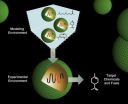(Press-News.org) Yale researchers have uncovered the molecular tricks used by bacteria to fight the effects of fluoride, which is commonly used in toothpaste and mouthwash to combat tooth decay.
In the Dec. 22 online issue of the journal Science Express, the researchers report that sections of RNA messages called riboswitches – which control the expression of genes — detect the build-up of fluoride and activate the defenses of bacteria, including those that contribute to tooth decay.
"These riboswitches are detectors made specifically to see fluoride," said Ronald Breaker, the Henry Ford II Professor and chair of the Department of Molecular, Cellular and Developmental Biology and senior author of the study.
Fluoride in over-the-counter and prescription toothpastes is widely credited with the large reduction in dental cavities seen since these products were made available beginning in the 1950s. This effect is largely caused by fluoride bonding to the enamel of our teeth, which hardens them against the acids produced by bacteria in our mouths. However, it has been known for many decades that fluoride at high concentrations also is toxic to bacteria, causing some researchers to propose that this antibacterial activity also may help prevent cavities.
The riboswitches work to counteract fluoride's effect on bacteria. "If fluoride builds up to toxic levels in the cell, a fluoride riboswitch grabs the fluoride and then turns on genes that can overcome its effects," said Breaker.
Since both fluoride and some RNA sensor molecules are negatively charged, they should not be able to bind, he notes.
"We were stunned when we uncovered fluoride-sensing riboswitches" said Breaker. "Scientists would argue that RNA is the worst molecule to use as a sensor for fluoride, and yet we have found more than 2000 of these strange RNAs in many organisms."
By tracking fluoride riboswitches in numerous species, the research team concluded that these RNAs are ancient — meaning many organisms have had to overcome toxic levels of fluoride throughout their history. Organisms from at least two branches of the tree of life are using fluoride riboswitches, and the proteins used to combat fluoride toxicity are present in many species from all three branches.
"Cells have had to contend with fluoride toxicity for billions of years, and so they have evolved precise sensors and defense mechanisms to do battle with this ion," said Breaker, who is also an investigator with the Howard Hughes Medical Institute. Now that these sensors and defense mechanisms are known, Breaker said, it may be possible to manipulate these mechanisms and make fluoride even more toxic to bacteria. Fluoride riboswitches and proteins common in bacteria are lacking in humans, and so these fluoride defense systems could be targeted by drugs. For example, the Yale team discovered protein channels that flush fluoride out of cells. Blocking these channels with another molecule would cause fluoride to accumulate in bacteria, making it more effective as a cavity fighter.
Fluoride is the 13th most common element in the earth's crust, and it is naturally present in high concentrations throughout the United States and elsewhere. Its use in toothpaste and its addition to city water supplies across the United States sparked a controversy 60 years ago, and the dispute continues to this day. In the United Kingdom, and in other European Union countries, fluoride is used to a much lesser extent due to fierce public opposition.
The new findings from Yale only reveal how microbes overcome fluoride toxicity. The means by which humans contend with high fluoride levels remains unknown, Breaker notes. He adds that the use of fluoride has had clear benefits for dental health and that these new findings do not indicate that fluoride is unsafe as currently used.
###Other Yale authors of the paper include: Jenny L. Baker, Narasimhan Sudarsan, Zasha Weinberg and Adam Roth.
The work was funded by the National Institutes of Health. Breaker is co-founder of a biotechnology company that has licensed intellectual property on riboswitches from Yale.
How bacteria fight flouride
2011-12-23
ELSE PRESS RELEASES FROM THIS DATE:
Genetic study of black chickens shed light on mechanisms causing rapid evolution in domestic animals
2011-12-23
The genetic changes underlying the evolution of new species are still poorly understood. For instance, we know little about critical changes that have happened during human evolution. Genetic studies in domestic animals can shed light on this process due to the rapid evolution they have undergone over the last 10,000 years. A new study published today describes how a complex genomic rearrangement causes a fascinating phenotype in chickens.
In the study published in PLoS Genetics researchers at Uppsala University, Swedish University of Agricultural Sciences, North Carolina ...
Rapid evolution in domestic animals sheds light on the genetic changes underlying evolution
2011-12-23
A new study describes how a complex genomic rearrangement causes a fascinating phenotype in chickens in which a massive expansion of pigment cells not only makes the skin and comb black, but also results in black internal organs. Published in PLoS Genetics, researchers at Uppsala University, the Swedish University of Agricultural Sciences, North Carolina State University, and National Chung-Hsing University investigated the genetic basis of fibromelanosis, a breed characteristic of the Chinese Silkie chicken.
"We have shown that the genetic change causing fibromelanosis ...
Chinese fossils shed light on the evolutionary origin of animals from single-cell ancestors
2011-12-23
All life evolved from a single-celled universal common ancestor, and at various times in Earth history, single-celled organisms threw their lot in with each other to become larger and multicellular, resulting, for instance, in the riotous diversity of animals. However, fossil evidence of these major evolutionary transitions is extremely rare.
The fossils, reported this week in Science, preserve stages in the life cycle of an amoeba-like organism dividing in asexual cycles, first to produce two cells, then four, eight, 16, 32 and so on, ultimately resulting in hundreds ...
Canine Trade Group Opens New 300-Acre Training Facility in Dover, Delaware
2011-12-23
One of the most extensive US-based dog training companies, Canine Trade Group, is proud to introduce a new 300 acre training facility in Dover, Delaware where its Professional Dog Trainer's Course will be held. Owned and operated by world-renowned dog trainer John Van Olden, Canine Trade Group offers customized training programs for dog trainers and their dogs. The new Dover Training Facility boasts a private, 20-run climate controlled kennel, an abundance of training field space, as well as accommodations such as on-site lodging or a country inn located less than a mile ...
Scientists engineer mosquito immune system to fight Malaria
2011-12-23
Researchers at the Johns Hopkins Malaria Research Institute have demonstrated that the Anopheles mosquito's innate immune system could be genetically engineered to block the transmission of malaria-causing parasites to humans. In addition, they showed that the genetic modification had limited impact on the mosquito's fitness under laboratory conditions. The researchers' findings are published December 22nd in the Open Access journal PLoS Pathogens.
In this study, Dimopoulos and his team genetically engineered Anopheles mosquitoes to produce higher than normal levels ...
Double trouble: Concomitant immune challenges result in CNS disease
2011-12-23
A research team led by Glenn Rall at the Fox Chase Cancer Center in Philadelphia, PA developed a novel mouse model to show that a fatal central nervous system (CNS) disease can be caused by a pathogen that does not replicate in the CNS. The results of this new study are published December 22nd in the Open Access journal PLoS Pathogens.
The authors found that the immune response induced in response to a peripheral viral infection can be "mis-recruited" to the brain, where these activated immune cells can then lead to inflammation-induced neuropathology and disease. While ...
CAD for RNA
2011-12-23
The computer assisted design (CAD) tools that made it possible to fabricate integrated circuits with millions of transistors may soon be coming to the biological sciences. Researchers at the U.S. Department of Energy (DOE)'s Joint BioEnergy Institute (JBEI) have developed CAD-type models and simulations for RNA molecules that make it possible to engineer biological components or "RNA devices" for controlling genetic expression in microbes. This holds enormous potential for microbial-based sustainable production of advanced biofuels, biodegradable plastics, therapeutic ...
For every road there is a tire
2011-12-23
KANSAS CITY, MO -- Life is complicated enough, so you can forgive the pioneers of DNA biology for glossing over transcriptional elongation control by RNA polymerase II, the quick and seemingly bulletproof penultimate step in the process that copies the information encoded in our DNA into protein-making instructions carried by messenger RNA.
In a new report appearing in the Dec. 23, 2011, issue of Molecular Cell, researchers at the Stowers Institute for Medical Research add not just a new layer, but a whole new dimension to transcriptional elongation control with evidence ...
Facebook Marketing Strategist Shows Chiropractors How to Get Endless New Patient Referrals from Social Media
2011-12-23
Chiropractic Internet marketing strategist and social media expert, Dr. Matthew Loop, has announced he'll continue to show DCs how to create an overwhelming presence on Facebook, which can easily net doctors an extra 20-30 new patients per month just from the social network. Dr. Loop's been helping fellow chiropractors master social media marketing since 2005-2006, which gives him an experience-based edge over other industry consultants.
He's garnered a well deserved reputation as the "go-to" guy for chiropractors that want to dramatically improve their new ...
Gene fusion in lung cancer afflicting never-smokers may be target for therapy
2011-12-23
December 22, 2011 – Smoking is a well-known risk factor for lung cancer, but nearly 25% of all lung cancer patients have never smoked. In a study published online today in Genome Research (www.genome.org), researchers have identified a previously unknown gene fusion event that could explain a significant proportion of lung cancer cases in never-smokers, and might serve as a target for new therapies.
Recent strides have been made to identify gene mutation events driving cases of lung adenocarcinoma in never-smokers, but the underlying genetic events leading to these lung ...



